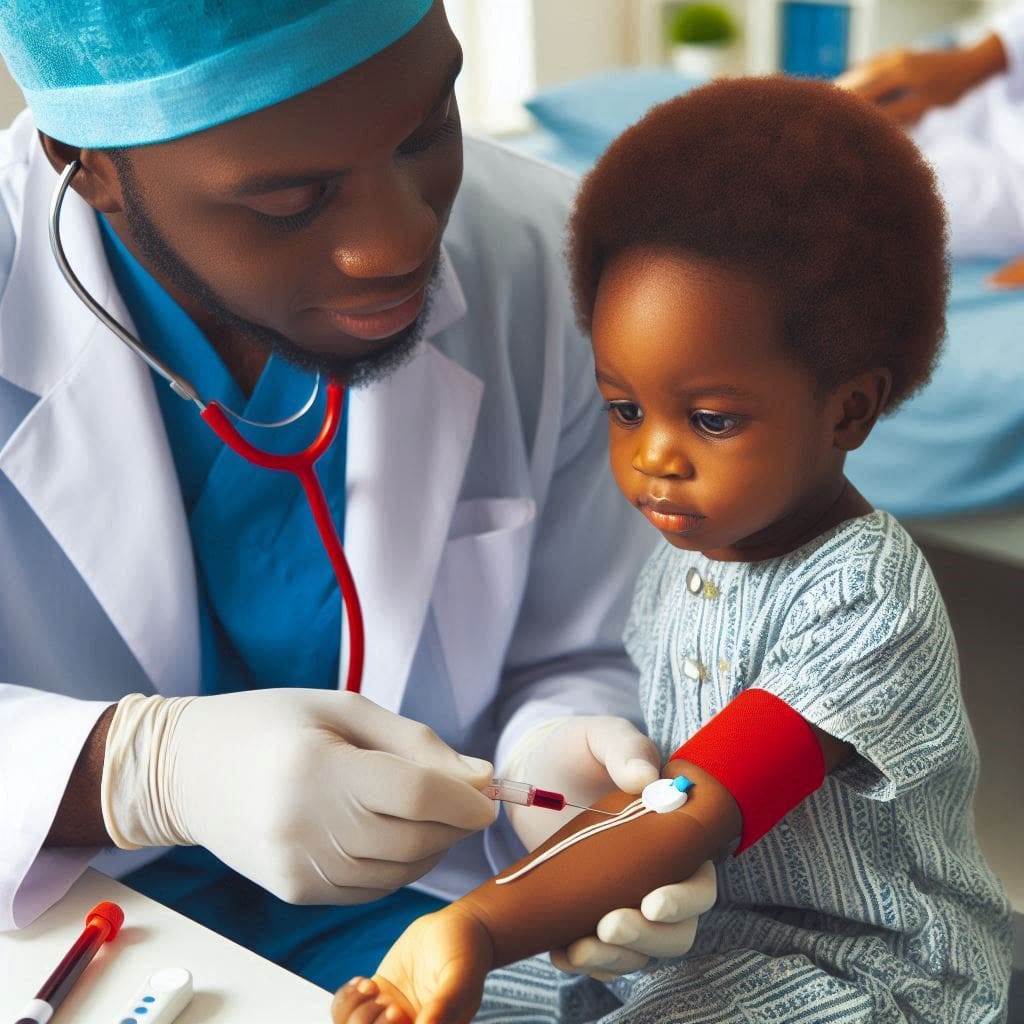Introduction
Childhood Anemia is a widespread public health issue in Nigeria, affecting an alarming number of children. Research indicates that 7 out of 10 children in Nigeria suffer from anemia, a condition characterized by a deficiency of red blood cells or hemoglobin.
This statistic is not just a number; it represents millions of young lives at risk of developmental delays, cognitive impairments, and even mortality. As a parent or caregiver, understanding childhood anemia is crucial for safeguarding your child’s future.
This article delves into the causes, symptoms, and solutions for childhood anemia, providing parents and caregivers with the knowledge they need to ensure the well-being of their children.
Understanding Anemia in Children
Childhood Anemia occurs when there is a reduction in the number of red blood cells or hemoglobin, which are essential for carrying oxygen throughout the body. In children, anemia can severely impact growth, cognitive development, and overall health.
The condition can be temporary or chronic, mild or severe, but in every case, it poses significant risks to the well-being of affected children.
Types of Anemia
Anemia in children is not a one-size-fits-all condition; it manifests in various forms, each with its unique causes and implications.
- Iron-Deficiency Anemia: The most common type, caused by a lack of iron, which is crucial for producing hemoglobin. This type of anemia is particularly prevalent in Nigeria due to dietary insufficiencies and high rates of parasitic infections.
- Vitamin Deficiency Anemia: Caused by a deficiency in essential vitamins such as B12 and folate. These vitamins are necessary for the production and maturation of red blood cells. A lack of these nutrients can lead to megaloblastic anemia, where the bone marrow produces abnormally large and dysfunctional red blood cells.
- Hemolytic Anemia: Occurs when red blood cells are destroyed faster than they can be produced. This can be caused by genetic conditions, autoimmune diseases, or infections. Sickle cell anemia, a form of hemolytic anemia, is particularly common in Nigeria.
- Sickle Cell Anemia: A genetic condition prevalent in Nigeria, characterized by abnormally shaped red blood cells that can block blood flow, causing pain, organ damage, and severe anemia.
Causes of Anemia in Nigerian Children
Understanding the root causes of childhood anemia is the first step in prevention and management. Several factors contribute to the high prevalence of anemia among Nigerian children:
- Poor Nutrition: A significant number of children in Nigeria do not receive enough iron-rich foods such as meat, beans, and leafy greens. Iron deficiency is the leading cause of anemia in children worldwide. In Nigeria, poverty and food insecurity exacerbate this problem, leading to diets that are deficient in essential nutrients.
- Malaria: Nigeria accounts for a significant percentage of the global malaria burden. Frequent malaria infections can destroy red blood cells, leading to anemia. Children under five are particularly vulnerable to this cycle of infection and anemia, which can be life-threatening if not properly managed.
- Intestinal Worms: Parasitic infestations, such as hookworms and schistosomiasis, are common in Nigeria and contribute to blood loss and iron deficiency. These worms feed on the blood of their host, leading to chronic blood loss and anemia, especially in children who already have limited nutritional reserves.
- Genetic Factors: Sickle cell disease, which affects about 2-3% of the Nigerian population, is a significant contributor to anemia. Children with sickle cell disease are prone to frequent hemolytic crises, where their red blood cells break down prematurely, leading to severe anemia.
- Inadequate Healthcare: Limited access to healthcare services, especially in rural areas, leads to delayed diagnosis and treatment of anemia. Many cases go undetected until they reach a severe stage, where the risk of complications and mortality is high.
Symptoms of Anemia in Children
Recognizing the signs of anemia is crucial for early intervention. The symptoms of anemia in children can vary depending on the severity and type of anemia, but commonly include:
- Pale Skin: A lack of red blood cells causes a pale appearance, particularly noticeable on the face, palms, and inside the lower eyelids.
- Fatigue: Anemic children often tire easily because their bodies are not getting enough oxygen to sustain energy levels. This fatigue can interfere with their ability to play, learn, and engage in daily activities.
- Shortness of Breath: Reduced oxygen levels can cause difficulty in breathing, especially during physical activities. Even mild exertion can leave an anemic child breathless and exhausted.
- Dizziness and Headaches: Anemia reduces blood flow to the brain, leading to dizziness, lightheadedness, and frequent headaches. These symptoms can affect a child’s concentration and performance in school.
- Irritability: Anemic children may become irritable and cranky due to the constant fatigue and discomfort they experience.
- Slow Growth and Development: Anemia can stunt growth and delay developmental milestones. Children may fall behind their peers in height, weight, and cognitive abilities.
- Heart Palpitations: In severe cases, the heart may work harder to compensate for the lack of oxygen in the blood, leading to palpitations or an irregular heartbeat.
The Impact of Anemia on Child Development
Anemia can have long-term consequences on a child’s development:
1. Cognitive Impairment
Anemia affects brain function, leading to difficulties in learning and concentration. Iron is critical for brain development, and its deficiency can impair cognitive abilities, resulting in lower academic performance and behavioral issues.
Studies have shown that anemic children score lower on tests of attention, memory, and learning compared to their non-anemic peers.
2. Physical Growth Delays
Chronic anemia can slow down physical growth, leading to stunted height and weight. This is particularly concerning in Nigeria, where many children are already at risk of malnutrition.
Stunted growth not only affects a child’s physical appearance, but also their overall health and ability to fight infections.
3. Weakened Immunity
Anemic children are more susceptible to infections due to weakened immune systems. Iron is essential for the production and function of immune cells, and a deficiency can leave children vulnerable to a range of illnesses.
This creates a vicious cycle where infections worsen anemia, and anemia increases susceptibility to infections.
4. Behavioral Issues
Children with anemia may exhibit behavioral problems such as irritability, hyperactivity, and mood swings. These behaviors can be challenging for parents and teachers to manage, and they can disrupt a child’s social interactions and learning environment.
Preventing and Managing Anemia in Nigerian Children
Combating anemia requires a multi-faceted approach involving nutrition, healthcare, and public awareness.
1. Nutrition
Proper nutrition is the cornerstone of anemia prevention and management. Parents and caregivers can take the following steps to ensure their children receive the necessary nutrients:

- Iron-Rich Foods: Incorporate foods like red meat, fish, poultry, beans, and iron-fortified cereals into your child’s diet. For children who do not consume meat, plant-based sources of iron such as lentils, spinach, and fortified cereals can be valuable. It’s also essential to combine these foods with vitamin C-rich foods, which enhance iron absorption.
- Vitamin C: Foods rich in vitamin C, such as oranges, tomatoes, bell peppers, and strawberries, help enhance iron absorption. Encouraging children to eat a variety of fruits and vegetables can improve their overall nutrient intake and support better iron absorption.
- Folate and B12: Include green leafy vegetables, eggs, and dairy products in meals to ensure adequate intake of these essential vitamins. Folate is necessary for the production of healthy red blood cells, while vitamin B12 is critical for maintaining the nervous system and preventing anemia.
2. Regular Health Check-ups
Regular health check-ups are essential for early detection and management of anemia:

- Routine Screening: Regular blood tests can help detect anemia early, allowing for timely intervention. Pediatricians can monitor a child’s hemoglobin levels and provide guidance on dietary adjustments or supplementation if needed.
- Deworming Programs: Participation in school-based deworming programs can reduce the risk of anemia caused by parasitic infections. These programs, often conducted by government health services, can significantly lower the prevalence of intestinal worms and related anemia in school-aged children.
3. Malaria Prevention
Malaria prevention is critical in reducing anemia rates among Nigerian children:

- Use of Insecticide-Treated Nets (ITNs): Protect children from malaria by using ITNs. These nets are treated with insecticides that kill or repel mosquitoes, significantly reducing the risk of malaria transmission.
- Prompt Treatment: Ensure immediate treatment for malaria to prevent complications like anemia. Parents should be vigilant in recognizing the symptoms of malaria and seek prompt medical attention if their child develops a fever or other signs of the disease.
4. Public Health Initiatives
Community-wide efforts are necessary to combat anemia at a population level:
- Community Education: Raising awareness about the importance of nutrition, hygiene, and preventive healthcare can significantly reduce anemia rates. Educational campaigns targeting parents, caregivers, and community leaders can help spread knowledge about anemia prevention and management.
- Supplementation Programs: Government and NGOs should continue and expand iron supplementation programs for children in high-risk areas. These programs can provide essential nutrients to children who may not get enough from their diets alone. Additionally, promoting the use of iron-fortified foods can help address widespread nutritional deficiencies.
Overcoming Challenges in Combating Anemia
Addressing childhood anemia in Nigeria involves overcoming several challenges:
1. Cultural and Dietary Practices
In some Nigerian communities, cultural beliefs and dietary practices may limit the intake of certain foods that are rich in iron and other essential nutrients. For example, taboos against eating eggs or meat can contribute to iron deficiency in children.
Addressing these challenges requires culturally sensitive education that respects traditions while promoting better nutritional practices.
2. Economic Barriers
Poverty is a significant barrier to proper nutrition and healthcare. Many families in Nigeria struggle to afford iron-rich foods, medical care, and preventive measures like insecticide-treated nets.
Addressing these economic barriers involves not only improving access to affordable nutritious foods but also strengthening social support systems that help vulnerable families.
3. Healthcare Access
Limited access to healthcare, especially in rural areas, makes it difficult to diagnose and treat anemia early. Strengthening healthcare infrastructure, increasing the availability of trained healthcare workers, and expanding outreach services, can help ensure that more children receive the care they need.
4. Education and Awareness
A lack of awareness about anemia and its consequences can lead to delayed diagnosis and treatment. Parents and caregivers may not recognize the signs of anemia or may not understand the importance of nutrition and preventive healthcare.
Increasing education and awareness through community programs, school curricula, and media campaigns can empower families to take proactive steps in preventing and managing anemia.
The Role of Schools in Combating Anemia
Schools play a crucial role in the fight against childhood anemia. As centers of learning and community engagement, schools can implement various programs to promote child health and nutrition:
- School Feeding Programs: Implementing or strengthening school feeding programs that provide balanced meals can ensure that children receive at least one nutritious meal a day. These programs can be particularly beneficial in low-income areas where children may not have access to adequate nutrition at home.
- Health Education: Schools can incorporate health education into their curricula, teaching children about the importance of nutrition, hygiene, and disease prevention. Educating children about the sources of iron and other essential nutrients can encourage healthy eating habits that last a lifetime.
- Deworming and Malaria Prevention Initiatives: Schools can partner with health agencies to conduct regular deworming and malaria prevention campaigns. By providing deworming medication and distributing insecticide-treated nets, schools can help reduce the burden of anemia in their student populations.
- Health Screenings: Regular health screenings at school can help identify children at risk of anemia. School nurses or visiting healthcare providers can conduct simple tests to check for signs of anemia and refer children for further evaluation if needed.
The Importance of Government and Community Support
Government policies and community initiatives are vital in the fight against childhood anemia. By prioritizing child health in national development plans, the government can ensure that resources are allocated to address this critical issue.
- National Nutrition Programs: The Nigerian government can strengthen national nutrition programs that focus on improving the dietary intake of children, particularly in underserved regions. These programs can include subsidies for iron-rich foods, public awareness campaigns, and support for local agriculture to increase the availability of nutritious foods.
- Healthcare Infrastructure: Investing in healthcare infrastructure, especially in rural areas, is essential for improving access to diagnosis and treatment of anemia. Mobile clinics, telemedicine services, and community health workers can extend the reach of healthcare services to remote areas where anemia is most prevalent.
- Partnerships with NGOs and International Organizations: Collaborating with NGOs and international organizations can bring additional resources and expertise to the fight against anemia. These partnerships can support large-scale interventions, such as mass supplementation programs and public health campaigns, that address the root causes of anemia.
- Community Engagement: Empowering communities to take an active role in promoting child health can lead to more sustainable outcomes. Community leaders, religious organizations, and local groups can play a key role in educating families about anemia and mobilizing support for prevention and treatment initiatives.
Conclusion
Childhood anemia is a significant public health challenge in Nigeria, with far-reaching consequences for the nation’s future.
However, it is a challenge that can be overcome with a comprehensive approach that includes proper nutrition, regular health check-ups, malaria prevention, and community-wide initiatives.
To help Nigerian children stay healthy and grow strong, we need to find out why they develop anemia and then make sure they get the right care to prevent and treat it. This way, we can make sure that every child has the chance to grow up healthy and strong.
Parents, caregivers, schools, communities, and the government all have a role to play in combating childhood anemia.



